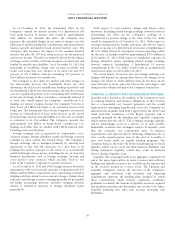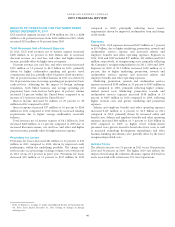American Express 2011 Annual Report Download - page 44
Download and view the complete annual report
Please find page 44 of the 2011 American Express annual report below. You can navigate through the pages in the report by either clicking on the pages listed below, or by using the keyword search tool below to find specific information within the annual report.
AMERICAN EXPRESS COMPANY
2011 FINANCIAL REVIEW
Income Taxes
The effective tax rate was 35 percent for 2011 compared to 37
percent and 30 percent for 2010 and 2009, respectively. The tax
rates for each of these years reflect the benefits from the
resolution of certain prior years’ tax items and the relationship of
recurring permanent tax benefits to varying levels of pretax
income.
INTERNATIONAL CARD SERVICES
SELECTED INCOME STATEMENT DATA
Years Ended December 31,
(Millions) 2011 2010 2009
Revenues
Discount revenue, net card fees and other $ 4,361 $ 3,678 $ 3,442
Interest income 1,304 1,393 1,509
Interest expense 426 428 427
Net interest income 878 965 1,082
Total revenues net of interest expense 5,239 4,643 4,524
Provisions for losses 268 392 1,211
Total revenues net of interest expense after
provisions for losses 4,971 4,251 3,313
Expenses
Marketing, promotion, rewards and
cardmember services 1,857 1,612 1,221
Salaries and employee benefits and other
operating expenses 2,352 2,050 1,821
Total 4,209 3,662 3,042
Pretax segment income 762 589 271
Income tax provision (benefit) 39 52 (59)
Segment income $ 723 $ 537 $ 330
SELECTED STATISTICAL INFORMATION
As of or for the Years Ended December 31,
(Billions, except percentages
and where indicated) 2011 2010 2009
Card billed business $ 124.2 $ 107.9 $ 94.9
Total cards-in-force (millions) 15.3 15.0 15.0
Basic cards-in-force (millions) 10.5 10.4 10.5
Average basic cardmember
spending (dollars)*$ 11,935 $ 10,366 $ 8,758
International Consumer Travel:
Travel sales (millions) $ 1,324 $ 1,126 $ 985
Travel commissions and fees/sales 7.8% 8.0% 8.6%
Total segment assets $ 29.1 $ 25.3 $ 23.0
Segment capital (millions) $ 2,840 $ 2,199 $ 2,262
Return on average segment capital(a) 25.8% 25.1% 15.0%
Return on average tangible
segment capital(a) 49.8% 34.8% 20.0%
Cardmember receivables:
Total receivables $7.2$ 6.7 $ 5.9
90 days past billing as a % of total(b) 0.9% 1.0% 2.1%
Netlossratio(asa%ofcharge
volume)(b) 0.15% 0.24% 0.36%
Cardmember loans:
Total loans $8.9$ 9.3 $ 9.2
30 days past due loans as a % of total 1.7% 2.3% 3.3%
Average loans $8.8$ 8.6 $ 8.9
Net write-off rate — principal only(c) 2.7% 4.6% 6.8%
Net write-off rate — principal, interest
and fees(c) 3.3% 5.5% 8.0%
Net interest income divided by
average loans(d)(e) 10.0% 11.2% 12.2%
Net interest yield on cardmember
loans(d) 9.9% 11.1% 12.2%
* Proprietary cards only.
(a) Return on average segment capital is calculated by dividing (i) one-year
period segment income ($723 million, $537 million and $330 million for
2011, 2010 and 2009, respectively) by (ii) one-year average segment capital
($2.8 billion, $2.1 billion and $2.2 billion for 2011, 2010 and 2009,
respectively). Return on average tangible segment capital is computed in the
same manner as return on average segment capital except the computation
of average tangible segment capital, a non-GAAP measure, excludes from
average segment capital average goodwill and other intangibles of $1.3
billion, $592 million and $551 million as of December 31, 2011, 2010 and
2009, respectively. The Company believes that return on average tangible
segment capital is a useful measure of the profitability of its business.
(b) Effective January 1, 2010, the Company revised the time period in which
past due cardmember receivables in ICS are written off to when they are 180
days past due or earlier, consistent with applicable bank regulatory guidance
and the write-off methodology for USCS. Previously, receivables were
written off when they were 360 days past billing or earlier. Therefore, the net
write-offs for the first quarter of 2010 include net write-offs of
approximately $60 million for ICS resulting from this write-off methodology
change, which increased the net loss ratio and decreased the 90 days past
billing metric for this segment, but did not have a substantial impact on
provisions for losses.
(c) Refer to “Consolidated Results of Operations”, footnote (b) on page 20.
(d) See table below for the calculation of net interest yield on cardmember
loans, a non-GAAP measure, and net interest income divided by average
loans, a GAAP measure.
(e) Refer to “Consolidated Results of Operations — Selected Statistical
Information”, footnote (g) on page 20.
42
























